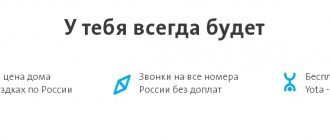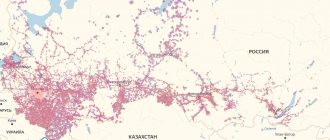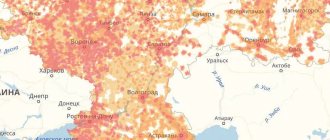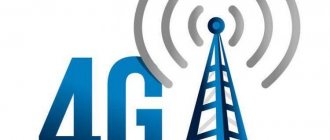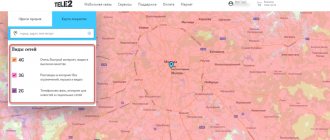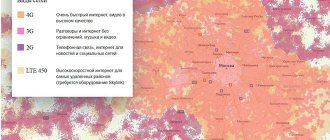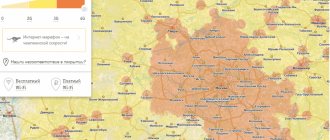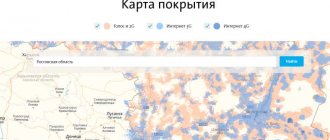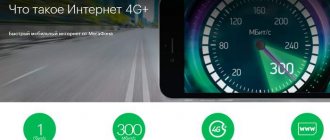To provide quality services to subscribers, MTS has created a modern telecommunications infrastructure, including its own mobile networks and services available to subscribers.
MTS coverage area
Currently, the operator offers a whole range of telecommunications services based on three main standards. A map of MTS coverage in the capital and regions is posted on this page, including the zones:
- 2G – cellular telephone communications;
- 3G – telephone communications and services, including conference calls, voice mail, access to multimedia and the Internet at a limited speed;
- 4G (LTE) – Internet, access to multimedia and various communication services, TV, video, video communication without speed limits.
Currently, MTS has deployed a serious technical infrastructure that allows it to receive various communication services while meeting the requirements for reliability, security, confidentiality and signal stability. Work continues on services that will be available to subscribers in the near future.
The proposed coverage map will help determine whether your geographic location falls within the MTS coverage area. At the same time, keep in mind that the Internet speed will be higher if you move no faster than 12 km per hour (namely, on foot or on a bicycle), slower if you are in a car. When moving between coverage areas of Moscow and other regions, seamless switching is carried out, invisible to the subscriber.
To use 4G (LTE), you need a special USIM SIM card and a device that supports LTE.
What affects the quality of reception
The coverage area is influenced by external factors, such as:
- the shape and contours of the terrain surface - communication in open spaces, and especially on hills, is better;
- type of building - unstable in solid buildings without windows;
- weather conditions - if unfavorable, quality decreases;
- user load on the network;
- technical equipment of the phone.
But the main influence is the presence and location of radio towers and base stations.
MTS coverage area in Russia
Many subscribers connect to MTS because they know that this company provides the largest reception area in Russia. You will have MTS communications available almost anywhere in the country. If you want to make sure of this, use the MTS coverage map in Russia. When doing so, pay attention to the communications standards you typically use and the availability of services where you travel. A current coverage map for MTS in Crimea is available on the website, which will be useful for residents of the peninsula to assess the available signal in their area of residence.
Service on the official website
Anyone, even an unregistered user, can use the “Coverage Map” service, presented in the “Help and Maintenance” section on the website www.mts.by. It will allow you to clearly see on a virtual map the territory where the company’s subscribers can be confident of receiving a high-quality signal and not experience problems with cellular communications.
The cellular coverage map from MTS is divided into zones:
- 2G;
- 3G;
- 4G.
The largest network coverage is 2G, and the smallest network coverage is 4G (Minsk and the capital region). It is enough to enter the exact address of the subscriber’s location into the search bar, including the city, street, house number, to make sure whether the given territory is within the network coverage area or not.
3g coverage map
You can expand your coverage area by using an external antenna. Just keep in mind that the signal amplifier is a means of radio emission. Therefore, its unauthorized installation is prohibited at the legislative level. The right to install and configure is given to the telecom operator.
About LTE Advanced pro
Today, LTE Advanced pro operates in three bands: 800 MHz, 1800 MHz and 2600 MHz. Base stations in the 2600 MHz range are used at busy base stations in Minsk and all regional centers, and many regional centers of the country.
LTE coverage map (4G):
1
BS range:
LTE 800: The 800 MHz band (and lower bands) has a long range and is designed to provide broad geographic LTE coverage. It is in this range that networks are deployed in rural areas.
LTE 1800: The 1800 MHz band is the main one for providing mobile network coverage using LTE technology in populated areas. Using this range allows for a reasonable compromise between range, room penetration and throughput.
LTE 2600: the use of the 2600 MHz band provides improved network throughput, and therefore increased data transfer speeds in areas with the largest concentration of 4G users. Locations for base stations with this range are selected based on their workload and the needs of subscribers. Thus, subscribers can use 4G communications even more comfortably.
2
Average speed:
Information about network coverage is indicative; actual network coverage and actual data reception/transmission speed depend on the type and characteristics of the subscriber device, radio conditions at the subscriber's location, terrain features and meteorological conditions, and the number of subscribers with devices operating in the same cell.
Number of BS by operator, as of November 23, 2021:
The LTE network implementation project is one of the key ones in the beCloud product package. In December 2015, the first infrastructure operator launched commercial operation of high-speed data transfer technology LTE Advanced pro in the city of Minsk.
The contractor for the first stage of the project development was the Belarusian representative office of the large Chinese vendor Huawei, which is responsible for the timely supply of equipment for the LTE Advanced pro network, its installation and commissioning, as well as for the commissioning of finished systems to the customer.
LTE continues to be the dominant mobile telecommunications technology. According to the international association GSA (Global mobile Suppliers Association), 807 networks have already been launched in the world (as of March 2021) and 62% of subscribers worldwide use this technology.
Why is LTE Advanced pro technology needed?
- Increasing data transfer speeds in wireless networks,
- Possibility of providing a wider range of services to LTE users,
- Reducing the cost of services provided,
- Increasing the flexibility of using existing systems,
- Increasing the availability of mobile communications for subscribers of mobile operators.
In 2021, Ericsson Nikola Tesla Corporation supplied equipment and put into operation the LTE network in three more regions of the country - Gomel, Brest and Mogilev, and also provided appropriate equipment support - design, installation and commissioning. The partnership with beCloud included the second phase of construction of the Belarusian 4G network, as well as the necessary software updates and the provision of related
,” notes
Mikhail Duka, Deputy General Director for Telecommunications at beCloud.
A year later, the number of 4G base stations in Belarus exceeded one thousand, beCloud technical specialists recorded an explosive growth in the volume of downloaded data. The thousandth base is located near the settlement of Bykachino, in the Chinese-Belarusian industrial park “Great Stone”.
In June 2021, the number of 4G base stations has already exceeded three thousand. The 3000th base station was an 800 MHz base station located in the village. Gruzdovo, Polochansk village council .
The popularity of the technology is primarily explained by increased user interest, the number of base stations launched into commercial operation both in Minsk and in the regions of Belarus, as well as the expansion of the LTE network. The main advantage of LTE technology is much higher mobile Internet speeds. And if the maximum incoming speed for subscribers of Belarusian 3G networks is limited to 42 Mbit/s, then in the 4G network it reaches 150 Mbit/s or more (with an average speed of 25 Mbit/s in Minsk).
“Such changes allowed the infrastructure operator to unconditionally provide higher data transfer speeds for Belarusian users, even while maintaining a high load on base stations. I would like to add that such significant changes in the mobile services market in Belarus simply did not exist until now. beCloud, as an infrastructure operator, the only one developing technology in our region, managed to radically change the telecom business and in just three years make 4G available both in Minsk and in the regions"
, notes
beCloud CEO Oleg Sedelnik .
The capacity of the LTE network has increased by a quarter thanks to the additional frequency resource received by beCloud in the 1800 band. In addition, the operator is constantly working on the construction of new base stations. Thus, more than 2 thousand 4G base stations are already operating in the 1800 band alone.
In March 2021, the infrastructure operator announced that it would provide access to the 4G network to the mobile operator A1. A1 subscribers in Minsk and the Minsk region, as well as Gomel, were the first to use data transmission in the fourth generation network.
Since August 2021, the use of the 800 MHz band has begun in the Gomel region. Currently, the 800 MHz band is also available in the Minsk and Mogilev regions. This made it possible to provide the opportunity to use LTE technology to 95% of the population.
Contacting the company
You can count on improved communication by contacting the operator directly by phone or through social networks.
To do this, you need to correctly compose an appeal, indicating:
- settlement;
- terms of use of the mobile device;
- a detailed description of the problem.
Each request is subject to review and analysis. Experts offer methods to resolve problems. The address at which proposals are accepted on the official Internet resource: help.mts.by/hc/ru.
Coverage map
Reliable reception zones are given according to the state of the MTS network as of 01/01/2019.
The information on the areas of reliable reception* in 2G, 3G, 4G technologies shown on the map was obtained on the basis of computer modeling of the network signal strength for a height of 1.5 meters from ground level (5 meters from ground level when using external antennas) and confirmed by sample measurement results on the ground. Due to the natural conditions of radio wave propagation, the quality of services provided to the subscriber, including the data transmission speed, may change (deteriorate, be interrupted or be accompanied by interference) depending on the local features of the terrain and type of building, meteorological conditions, congestion of the cell and other network elements serving subscriber, on the technical characteristics and technical condition of the subscriber equipment used, near or inside buildings, in tunnels, basements and other underground structures, under the influence of high-altitude interference on high floors of buildings, and other reasons.
Modeling of a reliable reception zone inside buildings is carried out for the case of standard structures of external walls, where there are windows with glass without surface metallization and does not take into account the internal configuration of the building premises, the number of additional internal walls and their features. For rooms that do not have external windows or openings facing open areas, as well as in rooms screened from open areas by two or more walls, the presence of the reliable reception zone shown on the map inside buildings is not guaranteed.
More detailed information is in the Technical Terms of Service
This map is not an integral part of the contract for the provision of telecommunication services and may not reflect the real situation, since the coverage area is constantly expanding.
Actually measured quality parameters (indicators) for cellular communication services provided in the zone of reliable reception declared by MTS in open areas (outside buildings and cars) (BS signal level not less than -93dBm).
* areas of reliable reception are calculated in accordance with clause 5.7 of STB 1904-2011 and clause 143 of the Rules for the provision of telecommunication services, approved by Resolution of the Council of Ministers of the Republic of Belarus dated August 17, 2006 N 1055
If you have any suggestions for coverage, please contact https://help.mts.by/hc/ru
